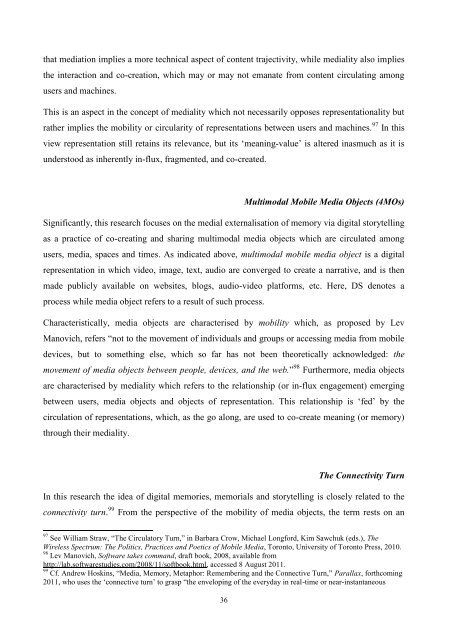UNIVERSITY OF NOVA GORICA GRADUATE SCHOOL ...
UNIVERSITY OF NOVA GORICA GRADUATE SCHOOL ...
UNIVERSITY OF NOVA GORICA GRADUATE SCHOOL ...
Create successful ePaper yourself
Turn your PDF publications into a flip-book with our unique Google optimized e-Paper software.
that mediation implies a more technical aspect of content trajectivity, while mediality also implies<br />
the interaction and co-creation, which may or may not emanate from content circulating among<br />
users and machines.<br />
This is an aspect in the concept of mediality which not necessarily opposes representationality but<br />
rather implies the mobility or circularity of representations between users and machines. 97 In this<br />
view representation still retains its relevance, but its ‗meaning-value‘ is altered inasmuch as it is<br />
understood as inherently in-flux, fragmented, and co-created.<br />
Multimodal Mobile Media Objects (4MOs)<br />
Significantly, this research focuses on the medial externalisation of memory via digital storytelling<br />
as a practice of co-creating and sharing multimodal media objects which are circulated among<br />
users, media, spaces and times. As indicated above, multimodal mobile media object is a digital<br />
representation in which video, image, text, audio are converged to create a narrative, and is then<br />
made publicly available on websites, blogs, audio-video platforms, etc. Here, DS denotes a<br />
process while media object refers to a result of such process.<br />
Characteristically, media objects are characterised by mobility which, as proposed by Lev<br />
Manovich, refers ―not to the movement of individuals and groups or accessing media from mobile<br />
devices, but to something else, which so far has not been theoretically acknowledged: the<br />
movement of media objects between people, devices, and the web.‖ 98 Furthermore, media objects<br />
are characterised by mediality which refers to the relationship (or in-flux engagement) emerging<br />
between users, media objects and objects of representation. This relationship is ‗fed‘ by the<br />
circulation of representations, which, as the go along, are used to co-create meaning (or memory)<br />
through their mediality.<br />
The Connectivity Turn<br />
In this research the idea of digital memories, memorials and storytelling is closely related to the<br />
connectivity turn. 99 From the perspective of the mobility of media objects, the term rests on an<br />
97 See William Straw, ―The Circulatory Turn,‖ in Barbara Crow, Michael Longford, Kim Sawchuk (eds.), The<br />
Wireless Spectrum: The Politics, Practices and Poetics of Mobile Media, Toronto, University of Toronto Press, 2010.<br />
98 Lev Manovich, Software takes command, draft book, 2008, available from<br />
http://lab.softwarestudies.com/2008/11/softbook.html, accessed 8 August 2011.<br />
99 Cf. Andrew Hoskins, ―Media, Memory, Metaphor: Remembering and the Connective Turn,‖ Parallax, forthcoming<br />
2011, who uses the ‗connective turn‘ to grasp ―the enveloping of the everyday in real-time or near-instantaneous<br />
36

















